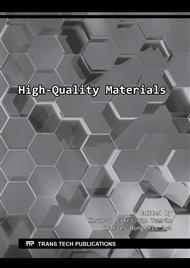[1]
Liu, R. H., Wang, Q. C., Lu, Fang, X. G. F. M. & Wang Y. Distribution and speciation of mercury in the peat bog of Xiaoxing'an Mountain, Northeastern China Environ. Pollution 124 (2003) 39-46.
DOI: 10.1016/s0269-7491(02)00432-3
Google Scholar
[2]
Lishtvan, II., Bazin, E. T. & Kosov, B. I.. Physical properties of peat and peat deposits (in Russia). Nauka I Technika Press, Miñsk 1 (1985) 134-145.
Google Scholar
[3]
ASTM D4427. Standard Classification of Peat Samples by Laboratory Testing. ASTM International, West Conshohocken, PA, USA (2002).
Google Scholar
[4]
Huat B. B. K., Prasad A., Asadi, A. & Kazemian S.. Geotechnics of Organic Soils and Peat. CRC Press, Balkema, (2014).
DOI: 10.1201/b15627
Google Scholar
[5]
Bell F.G.. Stabilization and treatment of clay soils with lime. Journal of Ground Engineering 21(1) (1983) 10-15.
Google Scholar
[6]
Munro R.. Dealing with bearing capacity problems on low volume roads constructed on peat. The Highland Council, Transport, Environmental & Community Service, HQ, Glenurquhart, Inverness IV3 5NX Scotland (2004).
Google Scholar
[7]
Mutalib, A. A., Lim, J. S., Wang, M. H. & Koonvai, L.. Characterization, distribution and utilization of peat in Malaysia. Proceeding of International Symposium on Tropical Peatland, Sarawak (1991).
Google Scholar
[8]
Jan U., Sonthwal V. K. & Kemi V. Soil Stabilization Using Shredded Rubber Tyre: A Review. International Journal of Civil and Structural Engineering Research 3(1) (2015) 57-60.
Google Scholar
[9]
Makusa, G. P. Soil stabilization methods and materials in engineering practice: State of the art review, Luleå University of Technology, Department of Civil, Environmental and Natural Resources Engineering, Mining and Geotechnical Engineering (2013).
Google Scholar
[10]
Kolay P. K., Aminur M. R. & Taib S. N. L. Stabilization of Tropical Peat Soil from Sarawak with Different Stabilizing Agents. Geotechnics Geology Engineering 29 (2011) 1135–1141.
DOI: 10.1007/s10706-011-9441-x
Google Scholar
[11]
Hamzah N., Mat Yusof N. A. & Mohd Raimi M. I. H. Assessment of Compressive Strength of Peat Soil with Sawdust and Rice Husk Ash (RHA) with Hydrated Lime as Additive. MATEC Web of Conferences, Vol. 258, 01014, International Conference on Sustainable Civil Engineering Structures and Construction Materials, SCESCM (2018).
DOI: 10.1051/matecconf/201925801014
Google Scholar
[12]
Ghani, A.N.A., Ahmad, F., Hamir R. & Mohd, S. Scrap Tire Based Lightweight Geomaterial for Civil Engineering Works. Proceeding of Malaysian Science Technology Congress, Genting Highlands, Malaysia (2002).
Google Scholar
[13]
Carreon, G.D. Stabilization of marginal soils using recycled materials. Master thesis University of South Florida, USA (2006).
Google Scholar
[14]
Bernal, A., Lovell C. W. & Salgado, R.. Laboratory Study on the Use of tire Shreds and Rubber-Sand in Backfilled and Reinforced Soil Applications. Publication FHWA/IN/JHRP-96/12. Joint Highway Research Project, Indiana Department of Transportation and Purdue University, West Lafayette, Indiana (1996).
DOI: 10.5703/1288284313259
Google Scholar
[15]
Chai, L. V. Strength Enhancement of Reinforced Peat- Rubber Crumb with Silica Fume as Additive. Bachelor thesis Universiti Malaysia Sarawak, Sarawak, Malaysia (2019).
Google Scholar
[16]
Sa'don, N. M., Karim, A. R. A., Taib, S. N. L. & Yusof, M.. Strength Properties of Properties of Reinforced Peat Using Fiber- Polyester and Shredded Rubber-Crumbs Reinforcement Material. International Journal of Engineering & Technology 3(18) (2018) 26-30.
DOI: 10.14419/ijet.v7i3.18.16667
Google Scholar
[17]
Munro, R., Evans R. & Searenketo, T.. ROADEX II project: Focusing in low-volume roads in the European northern periphery (2007).
DOI: 10.3141/1989-76
Google Scholar
[18]
Cabalar, A., Karabash, Z. & Mustafa, W. Stabilising a clay using tyre buffings and lime. Road Materials and Pavement Design 15 (2014).
DOI: 10.1080/14680629.2014.939697
Google Scholar
[19]
Bano, S., Syed, D. & Ahmad, A. Application of Waste Tyre in Highway Pavement: A Literature Review 5 (2019) 556-562.
Google Scholar
[20]
British Standard BS 1377. British standard methods of test for soils for civil engineering purposes part 1–9. British Standard Institution London. BS 1377-2:1990, ICS: 93.020, ISBN: 0 580 17867 6, Publisher: BSI, Total page: 68 (1990).
Google Scholar
[21]
Jawad, I.T., Taha. M. R., Majeed, Z. H. & Khan. T. A. Applied Science Engineering Technology 8(4) (2014) 510-520.
Google Scholar
[22]
Noto, S. Peat Engineering Handbook. Civil Engineering Research Institute, Hokaido Department Agency, Prime Minister's Office, Japan (1991).
Google Scholar
[23]
Hartlen, J. & Wolski, J. Embankments on Organic Soils. Elsevier, (1996).
Google Scholar
[24]
Ou, C. Y. Deep Excavation: Theory and Practice. CRC Press, The Netherlands, (2006).
Google Scholar
[25]
Huat, B. B. K. Deformation and Shear Strength Characteristics of Some Tropical Peat and Organic Soil. Pertanika J. Science & Technology 14(1&2) (2006) 61–74.
Google Scholar
[26]
Romali S. R. Strength Enhancement of Fibre Reinforcement Peat with Fly Ash as Stabilized Subgrade Layer. Master Thesis Universiti Malaysia Sarawak (2019).
DOI: 10.4028/www.scientific.net/ddf.411.109
Google Scholar
[27]
Shiva Prasad A., Ravjchandran, P. T., Annadurai R. & Kannan Rajkumar, P.R. Study on Effect of Crumb Rubber on Behavior of Soil. International journal of Geomatics and geosciences 4(3) (2014) 579-584.
Google Scholar
[28]
Md Zain N. H. & Zulastry M. I. Compressive Strength of Peat Soil Treated with Waste Tyre Granules. In: Awang M., Meor M Fared M. (eds) ICACE 2019. Lecture Noted in Civil Engineering, vol 59. Springer, Singapore (2020).
DOI: 10.1007/978-981-15-1193-6_21
Google Scholar
[29]
Zolfeghari Far, S. Y., Kassim, K. A., Eisazadehb, A. & Khari, M. An evaluation of the tropical soils subjected physicochemical stabilization for remote rural roads. The 2nd International Conference on Rehabilitation and Maintenance in Civil Engineering, Procedia Engineering 54 (2013) 817–826.
DOI: 10.1016/j.proeng.2013.03.075
Google Scholar
[30]
Hong, L. & Shahin, M. Utilization of shredded rubber tires for cement-stabilised soft clays. In: Puppala, A., Huang, J. Han, J. & Hoyos (eds) Ground Improvement and Geosynthetics – Proceedings of GeoShanghai International Conference, Shanghai, China, American Society of Civil Engineers (2010) 181- 186.
DOI: 10.1061/41108(381)24
Google Scholar
[31]
Saberian, M. & Rahgozar, M.A. Geotechnical properties of peat soil stabilised with shredded waste tyre chips in combination with gypsum, lime or cement. Mires and Peat. 18 (2016).
Google Scholar


